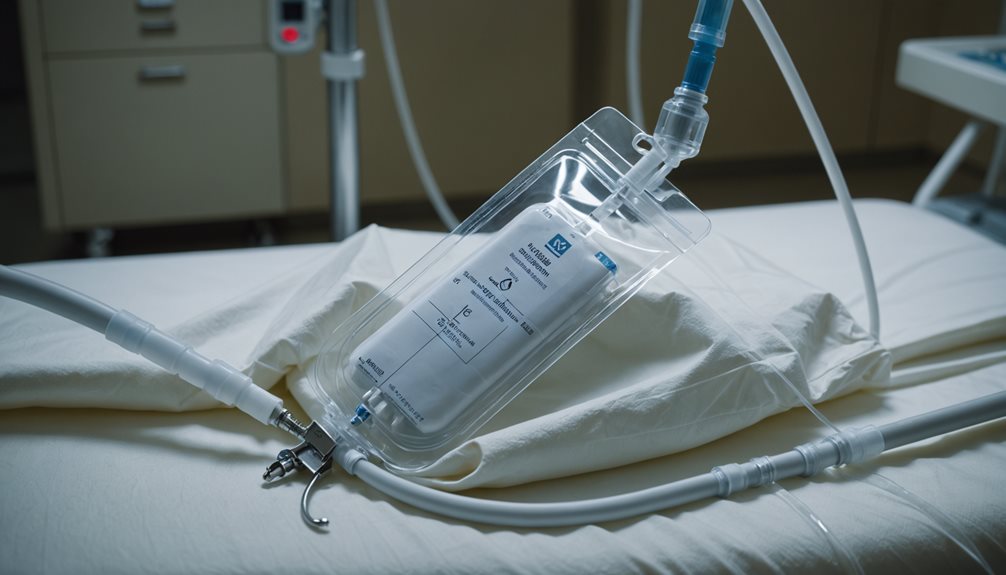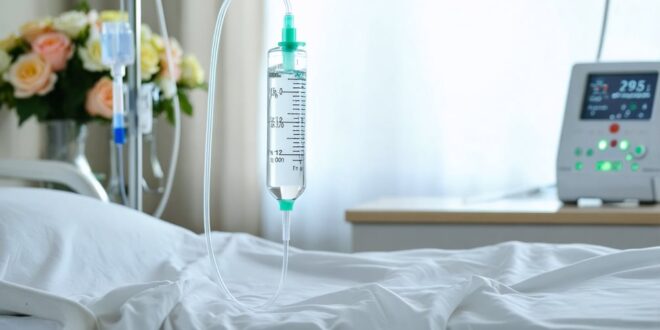If you can’t get enough nutrients through eating or tube feeding, parenteral nutrition might step in as a life-saving solution. It sends vital nourishment straight into your veins, bypassing your digestive system entirely. Whether it’s for a short recovery or a long-term necessity, this therapy changes how your body receives fuel. But how does it actually work, and when does someone need it? Let’s consider the essentials and the stakes involved.
Key Takeaways
- Parenteral nutrition delivers essential nutrients directly into the bloodstream, bypassing the digestive system.
- It is used when patients cannot eat or absorb nutrition through the gastrointestinal tract.
- Total parenteral nutrition (TPN) provides a complete nutritional formula via a central venous catheter.
- The solution is customized with water, glucose, amino acids, fats, vitamins, and minerals to meet individual needs.
- Parenteral nutrition requires close monitoring to manage risks such as infections and metabolic imbalances.
Definition and Purpose of Parenteral Nutrition

Parenteral nutrition is a method of supplying nutrients directly into the bloodstream through an intravenous line when the digestive system is unable to process or absorb food effectively. This approach bypasses the gastrointestinal tract entirely and is indicated in situations where oral or enteral feeding isn’t feasible or adequate.
Total parenteral nutrition (TPN) delivers a complete formulation of nutrients, including carbohydrates, proteins, fats, vitamins, and minerals, which are tailored to the individual’s specific requirements by healthcare professionals. The duration of parenteral nutrition may be short-term or long-term, depending on the underlying medical condition.
Regular monitoring is necessary to manage potential complications such as infection, metabolic imbalances, or liver dysfunction, and to ensure that nutritional needs are consistently met. Parenteral nutrition is considered a critical intervention for patients who can’t maintain adequate nutrition through traditional means.
Types of Parenteral Nutrition and Administration Methods
There are two primary methods for administering intravenous nutrition: Total Parenteral Nutrition (TPN) and Partial Parenteral Nutrition (PPN).
TPN is indicated when the gastrointestinal tract is nonfunctional or unsafe to use, and it involves delivering all essential nutrients through a central venous catheter. This approach is typically reserved for long-term nutritional support.
In contrast, PPN is used for short-term supplementation when oral or enteral intake is insufficient, and it’s administered through peripheral veins using a standard intravenous catheter.
Both methods require ongoing monitoring of nutrient intake, fluid balance, and laboratory values to minimize the risk of complications such as electrolyte imbalances or infections.
Healthcare providers regularly assess laboratory results and adjust the nutritional regimen as necessary to ensure patient safety and efficacy of treatment.
Composition and Customization of Parenteral Nutrition
The composition of parenteral nutrition is tailored to address the individual nutritional requirements of each patient. Intravenous feeding solutions typically contain water, glucose, amino acids, lipid emulsions, vitamins, and minerals in proportions designed to meet clinical needs.
The formulation of parenteral nutrition is adjusted based on patient-specific factors, such as laboratory data and the presence of particular nutrient deficiencies. Standard total parenteral nutrition (TPN) generally supplies 25–30 kcal/kg/day; however, caloric and macronutrient delivery may be modified to accommodate metabolic stress, organ dysfunction, or other patient conditions.
Three-in-one admixtures, which combine carbohydrates, proteins, and fats into a single container, can facilitate administration and reduce the risk of contamination.
Close monitoring of electrolyte concentrations and other laboratory parameters is essential for ongoing adjustment of the nutrition regimen. This approach helps to maintain adequate nutritional status and minimize the risk of complications during the course of parenteral nutrition therapy.
When Is Parenteral Nutrition Used?

Parenteral nutrition is indicated when patients are unable to obtain adequate nutrition through the gastrointestinal tract. This may occur due to conditions that impair nutrient absorption, such as significant gastrointestinal disease, obstruction, or following major surgical procedures.
Total parenteral nutrition becomes necessary when both oral and enteral feeding options aren’t feasible, for example, in cases of intestinal failure or in patients with altered levels of consciousness who can’t safely consume food.
Its use is more common among patients with prolonged hospital admissions, such as those receiving cancer treatment or among older adults with increased risk of malnutrition.
Parenteral nutrition involves the infusion of nutrients through an intravenous catheter, which provides an alternative route for meeting metabolic needs when conventional feeding methods are contraindicated or insufficient.
Benefits and Therapeutic Applications
Parenteral nutrition delivers nutrients directly into the bloodstream and is utilized when the digestive system is unable to process or absorb food adequately.
Total parenteral nutrition (TPN) provides essential macronutrients and micronutrients, which is necessary to prevent malnutrition in individuals with non-functional gastrointestinal tracts.
Clinical indications include conditions such as short bowel syndrome, severe gastrointestinal diseases, and situations where enteral feeding isn’t possible or sufficient.
TPN is used in both pediatric and geriatric populations, particularly during periods of recovery, growth, or when oral intake is inadequate.
The composition of parenteral nutrition can be tailored to address specific patient needs and deficiencies.
In some cases, home parenteral nutrition allows patients to maintain their nutritional requirements outside of the hospital setting.
Risks, Side Effects, and Complications
Parenteral nutrition is an essential therapy for patients unable to utilize their gastrointestinal tract, but its use is associated with several potential risks and complications.
Catheter-related infections are a significant concern, as they can lead to serious morbidity and mortality. Metabolic complications, including electrolyte imbalances, hypophosphatemia, and refeeding syndrome, may also occur and require careful monitoring and management.
Long-term total parenteral nutrition increases the risk of developing parenteral nutrition-associated liver disease (PNALD) and gallbladder complications related to bile stasis.
Additionally, patients may be at increased risk for venous thromboembolism, including pulmonary embolism, due to the presence of central venous access.
Regular assessment and prompt management of these risks are important to ensure the safety and effectiveness of parenteral nutrition therapy.
Long-Term Management and Patient Outlook

Long-term parenteral nutrition (PN) requires consistent and careful management to address the potential for cumulative complications.
Patients who receive PN at home need regular monitoring of weight, nutritional status, and relevant laboratory values to maintain optimal health outcomes.
Potential complications, such as parenteral nutrition-associated liver disease, may arise, underscoring the need for ongoing medical supervision, particularly during transitions to oral intake when possible.
A multidisciplinary healthcare team is typically involved in developing individualized nutrition plans, interpreting laboratory results, and managing associated risks.
With appropriate medical oversight, many patients can achieve satisfactory quality of life and reduce the likelihood of complications associated with long-term PN therapy.
 Mindful Vitals This is a blog about health.
Mindful Vitals This is a blog about health.

